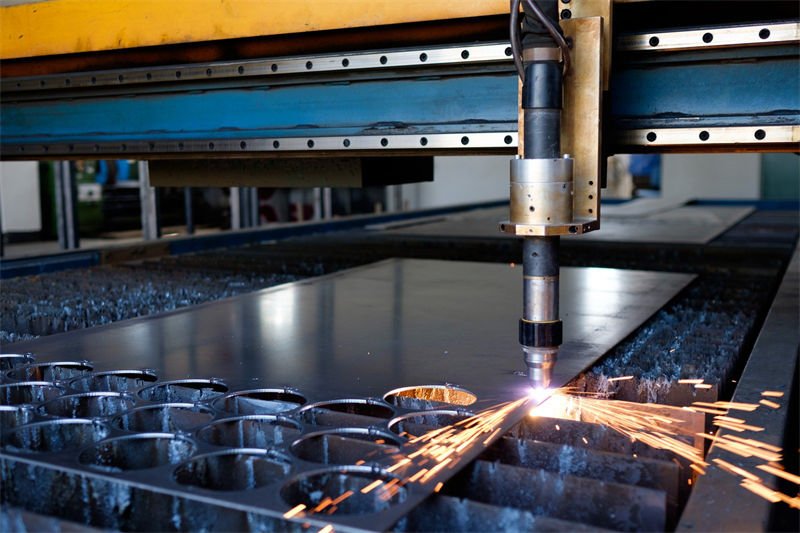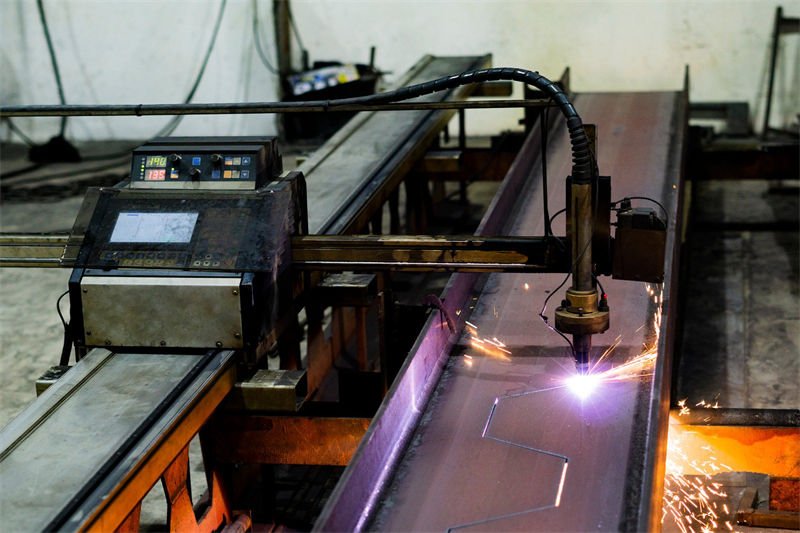
Did you ever experience the excitement of cutting metal as easily as slicing butter? That’s the wonder of CNC plasma cutters.
CNC plasma cutting machines offer precise cutting and quick operation. Automated control systems help the machines work well with different materials. These features turn them into vital tools in today’s fabrication work. They really improve efficiency and flexibility in working with metals. Efficiency and versatility are important.
Remember the first time I saw a CNC plasma cutting machine. It was like watching an artist create. The precision surprised me. The speed amazed me. Complex metal sheets turned into intricate designs with ease. These machines transform raw metal into precise shapes. Manual work can’t achieve this accuracy. Automated controls simplify operation. They really minimize mistakes. Consistency becomes a standard feature. Also, handling different materials really expands customization. This is crucial for everyone in metalworking. Endless possibilities arise.
CNC plasma cutters can cut through wood efficiently.False
CNC plasma cutters are designed for metals, not wood.
Automated control systems enhance precision in CNC plasma cutting.True
Automation ensures consistent, precise cuts by minimizing human error.
How Do CNC Plasma Cutters Achieve Precision?
Ever thought about how a CNC plasma cutter slices metal with precise accuracy? Let me explain the magic behind it.
CNC plasma cutters use advanced software controls for precision. A good torch design plays a role in achieving accurate cuts. Choosing the best gas is important. Precise machine calibration also matters. All these parts must work together. Together, they create neat cuts on metal.

The Role of Software Controls
Software in CNC plasma cutters acts like a conductor in an orchestra. It directs the cutter’s movements with great precision. I remember when I first saw how G-code programming1 directs the cutter’s path, speed, and settings. Advanced algorithms adjust for things like material thickness and kind, ensuring each cut is precise.
Quality Torch Design
Torch design is crucial for accuracy. I recall a time when a badly adjusted torch ruined many cuts. A good torch head stays at a steady distance from the material. Height control systems adjust in real-time based on sensor feedback.
| Component | Function |
|---|---|
| Torch Nozzle | Directs plasma arc |
| Swirl Ring | Controls gas flow |
| Electrode | Conducts electrical current |
Optimal Gas Selection
Choosing the right gas mix is like picking spices for a dish – important for flavor or, in this case, precision. Different gases change the arc’s stability and heat. Through trial and error, I found oxygen2 to quicken cuts while nitrogen reduces waste.
Machine Calibration
Calibration is a routine I greatly respect. It aligns machine parts, like tuning an instrument before a show. Regular checks on axis alignment and table leveling keep cuts precise. Once, I skipped this step and got poor results—a lesson learned! A calibration tool3 now simplifies adjustments.
Learning about these elements has changed how I handle CNC plasma cutting. I consistently produce high-quality work, maintaining accuracy and productivity across tasks.
G-code is used to control CNC plasma cutter paths.True
G-code programming dictates the cutter's path, speed, and parameters.
Torch nozzles in CNC cutters are not crucial for precision.False
Torch nozzles direct the plasma arc, essential for precision cuts.
What Materials Can Be Cut with CNC Plasma Machines?
Have you ever thought about the things you might slice with a CNC plasma machine? This curiosity puzzled me when I entered the fascinating realm of precise cutting.
CNC plasma machines cut metals that conduct electricity such as steel, stainless steel, aluminum, copper, brass and titanium with precision. These machines easily deal with metals that are several inches thick. They offer both accuracy and speed. Different projects benefit from their ability to cut well.

Conductive Metals
When I started using CNC plasma machines, I felt surprised by how they work with ferrous metals like mild steel and stainless steel. These metals are very strong and long-lasting. They suit many jobs perfectly. Cutting stainless steel4 for the first time left me in awe. The neat edges looked incredible!
Non-Ferrous Metals
These machines also handle non-ferrous metals such as aluminum and copper. Aluminum stands out because it is light. Working with aluminum5 completely changed our approach in an aerospace project.
Metal Thickness Abilities
CNC plasma machines impressively cut metals of different thicknesses. From thin sheets to thick slabs, they handle variety with ease. Here’s a simple table showcasing thickness capabilities:
| Metal Type | Maximum Thickness |
|---|---|
| Mild Steel | Up to 2 inches |
| Stainless Steel | Up to 1 inch |
| Aluminum | Up to 1.5 inches |
A simple chart helps me recall thickness limits. It’s very handy.
Limitations and Thoughts
CNC plasma machines have some limits. They don’t work well with non-conductive materials like plastics or glass. During a trial with acrylic, things didn’t go as planned. Quality of cuts depends on both the machine and the operator’s ability. High-definition cutters create sharp cuts required for detail work, as seen in precision applications6.
For special metals or finishes, laser cutting sometimes suits better. When I needed complex designs or non-metal materials, laser cutting7 provided the needed precision.
CNC plasma machines cut non-conductive materials.False
Plasma machines only cut conductive metals, not non-conductive materials.
Aluminum can be cut up to 1.5 inches thick with plasma.True
CNC plasma machines can cut aluminum up to 1.5 inches thick.
How Does Automation Enhance CNC Plasma Cutting?
Picture a world where machines slice metal with the accuracy of a master artist and the speed of a fast runner. Automation introduces this capability to CNC plasma cutting.
Automation helps CNC plasma cutting operate with better accuracy, consistency and efficiency. It lowers human mistakes, reduces waste and works easily on complex designs. This eventually increases productivity and lowers costs in manufacturing.

The Role of Automation in Precision
When I first started with CNC plasma cutters, I was stunned by the precise cuts. Yet, human errors always found a way in. Automation changes everything8. Imagine programming complex designs into a machine and watching it perform perfectly each time. Automation removes guesswork and increases precision.
Table: Benefits of Automated Precision
| Feature | Manual Process | Automated Process |
|---|---|---|
| Human Error | High | Low |
| Consistency | Variable | Uniform |
| Design Complexity | Limited | Advanced |
Efficiency and Speed
In the past, I monitored every cut closely, ensuring smooth operations. Now, automated CNC systems allow me to set it up and let it work, completing the task quickly and accurately. This results in less setup time and continuous operation. Fulfilling orders swiftly now surprises me. In business, time equals profit and this efficiency is not just helpful – it’s necessary.
Automated CNC systems significantly enhance the speed of production. With minimal setup time and the ability to run continuous operations, these systems dramatically reduce lead times. This efficiency enables businesses to meet high-demand orders9 swiftly, which is crucial in competitive markets.
Reducing Waste
Worrying about waste from scraps kept me awake at night. Automation calculates exact cut paths, greatly reducing waste. This decreases material costs and increases sustainability. It feels like having a very clever puzzle solver on my team.
One of the unsung benefits of automation in CNC plasma cutting is waste reduction. Automated systems optimize material usage by calculating precise cut paths10 that minimize off-cuts and scraps. This not only saves costs but also supports sustainable practices by reducing material wastage.
Advanced Programming Capabilities
Automated CNC plasma cutters offer advanced programming like having a design expert at your service. I can input highly complex designs with sophisticated software. This invites more innovation in design and manufacturing.
Automation empowers CNC plasma cutters with advanced programming capabilities. Operators can use sophisticated software to input complex designs, which the machines execute with high accuracy. This capability opens up new avenues for innovation in design and manufacturing.
Considering more automation means looking at the initial cost and the long-term benefits, such as fewer labor costs and better production capacity. To stay competitive, embracing technology is vital.
Businesses looking to stay competitive should explore how these technological advances11 can transform their operational efficiencies.
As automation advances, new possibilities for improving CNC plasma cutting across industries excite me.
Automation reduces human error in CNC plasma cutting.True
Automation minimizes manual intervention, lowering the risk of errors.
Manual CNC processes are faster than automated ones.False
Automated systems enhance speed by reducing setup time and running continuously.
What Are the Benefits of High-Speed CNC Plasma Cutting?
Have you ever felt like you’re moving slowly when you should be speeding up? That’s how it felt for me until I found high-speed CNC plasma cutting. Really high-speed.
High-speed CNC plasma cutting provides unmatched accuracy, quick production times and major cost reductions. This method is ideal for intricate designs and strong materials. Industries such as automotive and construction widely adopt this versatile technique.

Enhanced Precision
A high-speed CNC plasma cutter looks amazing when working. It resembles an artist creating with fire. This tool changes how we deal with complex designs, offering accurate cuts every time. The first time I saw it, the ability to reduce mistakes truly amazed me. It always delivers consistent quality—a real game-changer for anyone in automotive manufacturing12. The trick? A focused plasma jet melts and easily removes material.
| Feature | Benefit |
|---|---|
| Precision | Consistent quality |
| Intricate Cuts | Ideal for complex designs |
| Minimal Errors | Reduces material wastage |
Faster Production Times
Picture yourself racing against time. Every minute matters. Those tense moments wishing we’d hit our goals come to mind. High-speed CNC plasma cutting becomes life-saving then. It speeds up production, especially in high-demand areas like construction13. More parts get cut fast, helping businesses meet tight deadlines efficiently.
Cost Savings
Initially, investing in CNC plasma cutting may seem costly. But trust me, the long-term payback is great. Fewer secondary operations mean less labor and material expenses—a perfect fit for sheet metal workshops14 like mine. Better profit without skimping on quality? Absolutely!
Versatility Across Industries
CNC plasma cutting comes with incredible flexibility. It tackles both thin sheets and thick plates, making it a preferred choice across various industries.
- Automotive: Quickly creates precise parts.
- Aerospace: Manages different material thicknesses well.
- Shipbuilding: Effortlessly slices through thick steel plates.
Whether you make laser equipment15 or run manufacturing like I do, knowing these advantages is essential. It’s about more than speed; it’s about improving efficiency and quality outcomes. Honestly, once you try high-speed CNC plasma cutting, you won’t want anything else.
Learn more about this technology16 to see how it can transform your operations.
CNC plasma cutting reduces material wastage.True
The precision of CNC plasma cutting minimizes errors, reducing wastage.
High-speed CNC plasma cutting is not versatile.False
It's adaptable to various materials and thicknesses, offering versatility.
Conclusion
CNC plasma cutting machines provide precise, automated metal cutting with advanced software and torch design, enhancing efficiency, reducing waste, and enabling intricate designs across various industries.
-
G-code programming dictates the precise movements of CNC machines, ensuring accuracy in cutting paths and parameters. ↩
-
Oxygen increases cutting speed and quality by enhancing the plasma arc’s energy and stability. ↩
-
Calibration tools help align machine components accurately, ensuring precise cuts and preventing deviations. ↩
-
Learn why stainless steel is ideal for plasma cutting due to its strength and resistance to rust. ↩
-
Discover how aluminum’s lightweight properties make it essential in industries like aerospace. ↩
-
Explore how high-definition plasma cutters achieve precise cuts for detailed projects. ↩
-
Understand the key differences between laser and plasma cutting for diverse material applications. ↩
-
Discover the role of automation in enhancing precision and minimizing human errors in CNC plasma cutting. ↩
-
Learn how automation in CNC systems accelerates production times and helps meet high-demand orders efficiently. ↩
-
Explore how automated systems optimize material usage, leading to cost savings and sustainable practices. ↩
-
Understand the latest technological advancements in CNC plasma cutting that enhance operational efficiencies. ↩
-
Explore how precision in CNC plasma cutting enhances automotive manufacturing by reducing errors and improving component quality. ↩
-
Discover how CNC plasma cutting speeds up construction projects, ensuring quick turnaround times and efficiency. ↩
-
Understand how sheet metal workshops can reduce costs and increase profitability with CNC plasma cutting. ↩
-
Find out how CNC plasma cutting supports precision and efficiency in laser equipment manufacturing. ↩
-
Access an in-depth guide to understand how high-speed CNC plasma cutting can revolutionize your production processes. ↩



